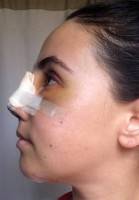Rhinoplasty Swelling Tip
Depending on the rhinoplasty and your skin type, recovery can range from 7 days to 20 days. The vast majority of patients need 12-14 days after rhinoplasty to be presentable. The first week there is no heavy lifting, bending over, or nose blowing to minimize the risk of a nosebleed. On day 7, usually the splint is removed, and the restrictions are lifted; however, most people still have some swelling tip and bruising that makes the rhinoplasty obvious.
Makeup during this second ‘social downtime’ week can help, but usually by 14 days, no one at work or school will know you had a rhinoplasty and by 21 days even your family won’t know you had anything done.
Despite the above, by the 3rd week only 60-70% of the swelling has subsided. The remaining of the swelling takes 12-18 months to dissipate depending on the rhinoplasty and skin type. (Mike Majmundar, MD, Atlanta Facial Plastic Surgeon)
Rhinoplasty swelling tip can vary significantly. The more surgery you had there, the thicker the tissue and open versus closed approach changes the time you can expect.
You should be ready for social engagements in about 3 weeks, but the time it takes for all of the swelling to resolve can vary based on these and other things from 3 to 12 months. (Timothy Janiga, MD, FACS, Reno Plastic Surgeon)
Rhinoplasty swelling tip
In general it takes two weeks to look presentable with perhaps some cover up for black and blue under the eyelids. It takes one month for 50% resolution, three months for 75%, and one year for the final result. The nasal tip swelling takes the longest to resolve. (George C. Peck, Jr, MD, West Orange Plastic Surgeon)
After rhinoplasty some swelling is normal as this is the way the bod naturally heals. Most of the swelling goes over the first 2-weeks however much more will go over the first 6-weeks, there can then be some fluctuation in swelling for a period of months, the final result is 12-months.
- 1-week: When the cast is removed after one week, the nose will look swollen, particularly the tip of the nose and some swelling along the bridge of the nose.
- 2-weeks: By the end of two weeks commonly 80% of the swelling has resolved, however there will still be swelling particularly in the fhinoplasty swelling tip of the nose and this will mask the fine detail at the nasal tip.
- 6-weeks: Most of the swelling has gone down, there can be fluctuations in swelling on a day by day basis
- 6-52 weeks: Gradual resolution of the swelling, that results in more definition being seen in the rhinoplasty swelling tip of the nose and nasal bridge.
There is a degree of swelling after rhinoplasty that is dependent on your ethnicity, genetics, environmental factors, and surgical factors including if the surgery included nasal tip surgery, nasal hump reduction and revision rhinoplasty. (Julian De Silva, MD, London Facial Plastic Surgeon)
Rhinoplasty recovery: swelling
Hard to tell you how long you will be swollen, but be patient. Early swelling ( first 6 weeks) is normal. It may take 1 year for all swelling to gradually resolve. (Jeffrey Ditesheim, MD, FACS, Charlotte Plastic Surgeon)
10 days will take for normal to have rhinoplasty most of the swelling. The final result will could take up to 1 year. (Jhonny Salomon, MD, Miami Plastic Surgeon)
Full Healing Can Take Several Months
As with any surgery, there are many things that impact how quickly you heal after a rhinoplasty. Your health, the type of surgery performed, and the length of the operation all factor in to the healing process.It usually takes about 2 weeks for the cast to come off and at this point the nose looks good, but it may have some swelling. It may take up to three months for the majority of the swelling to subside, but again it will look rather close to its final improved look.
If you feel that your nose is still swollen, steroid injections can help quickly get things back to your desired look. Talk with your physician to understand what type of procedure will be performed, and ask what the healing process has been like for the physician’s other patients. (Farhan Taghizadeh, MD, Albuquerque Facial Plastic Surgeon)
Swelling after rhinoplasty will go away in stages
Swelling after any surgery is normal. Its more noticeable and important in rhinoplasty procedures because the nose is a smaller and more refined structure as well as its importance in our appearance.
Rhinoplasty swelling tip will have several stages. Increase in swelling up to day 3 then stable, increase in swelling again after splint is removed, slow reduction of swelling over time with an appreciable amount of swelling going away in the first month and a flatter curve of swelling elimination over the following 6 months or more. (Remus Repta, MD, Scottsdale Plastic Surgeon)
The majority of acute swelling after a rhinoplasty should be gone in 10 days, however some swelling will persist for months and even up to 1 year.
Different surgeons have different technique and as such different degrees of post-op swelling.
I hold pressure on my osteotomie sites for 5 minutes after I do them and this greatly reduces post of swelling.
Also even a complicated rhinoplasty tip I can usually get done in less than 1 hour which reduces swelling. At 3 weeks post-op excessive swelling may indicate a problem. (Richard Galitz, MD, FACS, Miami Facial Plastic Surgeon)
The nose is one of those structures that takes a while to let go of swelling. The more surgery that was required, the greater the swelling, and resultingly, the longer the swelling will last. It is not unheard of for swelling to last a few weeks. However, by the 4 week time period the majority of the swelling should be down such that others don’t really notice it in public. However, if you stare at your nose in the mirror, you will not see fine tip details, etc. A full rhinoplasty tip can take 6-9 months to completely heal! (Raghu Athre, MD, Houston Facial Plastic Surgeon)
Swelling common 3 weeks following rhinoplasty tip
Swelling is normal 3 weeks following nasal surgery. If you’ve had an open or external rhinoplasty you can have moderate swelling for 6-8 weeks. You can expect gradual resolution of tissue swelling and improved definition of the tip from that point up to 12 months following surgery.Stephen Weber MD, FACS (Stephen Weber, MD, FACS, Denver Facial Plastic Surgeon)
You will not be able to notice the true results of your rhinoplasty tip immediately, particularly since initial swelling and bandages will obscure your view of the nose itself. After a week or two, your bandages and splints will be removed, allowing full view of the results, which will continue to unfold for up to a year after surgery.
It is important to be patient and follow your instructions specifically, in order to achieve the best results possible. (Ricardo A. Meade, MD, Dallas Plastic Surgeon)
Swelling can last a long time after rhinoplasty tip
It is completely normal for you to have swelling three weeks after rhinoplasty tip. This is especially true fot the lower one third of the nose. In some cases, swlling can persist for a year or even longer. (Jeffrey Roth, MD, Las Vegas Plastic Surgeon)
Swelling after rhinoplasty tip
It is very normal to have significant swelling at 3 weeks. Generally at 1 month, most people you meet for the first time will not know that you have had nasal surgery, but the swelling will take much longer to resolve.
Typically, it takes 6 months for swelling to disappear from the bridge, and 1 year or longer for tip and sidewall swelling to resolve.
An easy way to watch the resolution of swelling it to monitor the dents caused by sunglasses. They will become smaller and smaller with time. (Michael A. Bogdan, MD, FACS, Dallas Plastic Surgeon)
Rhinoplasty/nose job Swelling
The amount of swelling a person has postoperatively can vary by surgical technique, history of previous surgery, types of grafting materials used and your own skin thickness.
It is very common to still be swollen at this point. It takes 3 months at least for 90% of the swelling to resolve and one year for it to completely settle in patients who have not had nasal surgery before. It can take up to 2 years if you have had a previous procedure. It will get better! (Angela Sturm, MD, Houston Facial Plastic Surgeon)
Swelling of the Nose Following rhinoplasty tip
I advise my patients that 80% of swelling resolves over the first 2 months following rhinoplasty tip surgery and that final results will be achieved between the 6 and 12 months later. Tip swelling is the slowest to resolve and is usually more evident in thick skinned individuals. In a patient who has swelling that is excessive, a course of oral steroids or steroid injections may be considered, however, this would have to be discussed with your surgeon. (Andrew B. Denton, MD, Vancouver Facial Plastic Surgeon)
Post rhinoplasty swelling varies for each individual patient. Open rhinoplasty techniques tend to cause more post-operative swelling that persists for a longer time than closed rhinoplasty.
Most swelling will dissipate after 3-4 weeks. However there can be residual swelling and changes for up to 1 year especially with open rhinoplasty.
This be said, it usually is very minor swelling that the patient and doctor would appreciate and not so much friends and acquantances.
But, “open” definitely persist longer. Also increased activity level can increased post rhinoplasty swelling. (Steven Wallach, MD, Manhattan Plastic Surgeon)
Technically after a rhinoplasty (or any disruption of tissue that leads to inflammation and scar formation) there is some swelling up to or even beyond one year after surgery.
The obvious post rhinoplasty swelling that makes you look like you were recently operated is usually resolved within 10 -14 days. After this initial period there is a slow, gradual progression to your final result that can last 1-2 years.
Patients with thicker skin may notice swelling longer, but beyond the first two weeks it is most obvious to the patient and the surgeon. In short, patients are ready to go out in public within the first two weeks with minor improvements thereafter. (Javier Davila, MD, New Haven Plastic Surgeon)
Most of the bruising and and significant swelling should subside by the 2 -3 week mark, however you can expect some degree of swelling to last up to 12 months.
Depending on your tissues, it may still be reasonable to have a degree of swelling at the 3 week mark. Best to check with you surgeon that he is happy every thing is proceeding as planned.
Assuming all is well, then gentle massage may be helpful to seek the process. (Richard Bloom, MBBS, FRACS, Melbourne Plastic Surgeon)
Post rhinoplasty swelling can take weeks to months sometimes
Rhinoplasty can take weeks to up to a month or so for the swelliing to go down. Sometimes using steroids can help this swelling along. But you should be aware of the risks of steroids and thoroughly discuss this with your doctor.
Also, you should be aware that very subtle changes can actually take up to two years to really be noticeable. These subtleties most commonly take place at the nasal tip.
I would definitely avoid heat, as this can only make things worse by increasing the blood flow to the area, causing more inflammation and extending the inflammatory process.
Keeping your head elevated will help the swelling go down. Also considering very light exercise can also help the swelling by increasing your circulation. I usually suggest 15-20 minute walks 2-3 times a day to help the swelling.
With guidance, judicious use of pressure can help relieve the swelling but you should definitely talk with your doctor about this. (Philip Young, MD, Bellevue Facial Plastic Surgeon)
The swelling after rhinoplasty varies from patient to patient. In general, 70 % resolves in the first 6 weeks, 85% at 6 months, and 100% at one year. The thicker the skin, the longer it takes. (Andres Bustillo, MD, FACS, Miami Facial Plastic Surgeon)
Swelling after Rhinoplasty is normal due to numerous factors and here is why:
Having swelling 3 weeks after rhinoplasty is extremely reasonable. Typically the majority of swelling has resolved 6 weeks post-operatively but there is always some swelling that will persist, especially in the tip, for up to a year. There are numerous factors that can make the edema seen in the mirror resolve quicker or persist longer, so let’s explore them. The first factor would be whether or not the rhinoplasty was performed through an open technique, which involves a small incision near the base of the nose across the columella, and as a result allows for more extensive elevation of the soft tissues; as opposed to a closed rhinoplasty which has less dissection of the soft tissues.
In general, an open rhinoplasty approach will result in more swelling of the soft tissues of the nose do to the increased dissection that is performed. That is not to say that an open rhinoplasty is not an appropriate procedure since it gives the surgeon full visualization and access to the anatomic structures in order to diagnose and treat any asymmetries/ abnormalities. During an open rhinoplasty it is especially important that the surgeon stays within the appropriate surgical planes so that the soft tissues are not traumatized, resulting in undue increased swelling.
Refinement of this technique is only gained over years of experience with this technique. That is not to say that closed rhinoplasties don’t also have edema, and again staying true to the anatomic planes of the soft tissues of the nose is extremely important, but the amount of soft tissue elevation is much less extensive, and therefore its indications more limited.
All of that being said it, is still normal to have post rhinoplasty swelling for the first 6 weeks which shouldn’t limit you from every day type activities, but is not the ideal time to have keepsake photos taken, or attending important social events. After the initial 6 weeks the vast majority of the edema is usually gone in a primary rhinoplasty.
However there is always a small line of edema that is usually visible to the surgeon and patient which will wax and wane, and primarily involves the tip of the nose as it resolves over the next year. This is not swelling that other people can typically see; rather, only the patient and surgeon. Another factor that creates more and/or prolonged swelling is when it’s a revision rhinoplasty i.e. a second or third procedure on a patient that’s already had a previous rhinoplasty.
It is very common that the edema will persist longer in this scenario, but again, all of it always will eventually resolves over 12-18 months. A third important factor to be aware of when is the thickness of the nasal skin. Individuals who have thin skin in general have less swelling than those who have thicker skin, simply because the former have more soft tissue to absorb and retain fluid, resulting in more edema.
Finally, it also should be noted that the length of the procedure can also result in more post rhinoplasty swelling, and therefore once again a surgeon who is very experienced and efficient with his time in the operating will room will, in general, have less swelling for their patients. Things that patients can be done to minimize edema is elevating the head to 30-45 degrees on a Styrofoam wedge or sleeping in a recliner chair the first 1-2 weeks. In addition oral steroids the first week postop is helpful. Finally, be aware of your salt intake as that also can have an impact in what you see in the mirror the next day! (Burke Robinson, MD, Atlanta Facial Plastic Surgeon)



